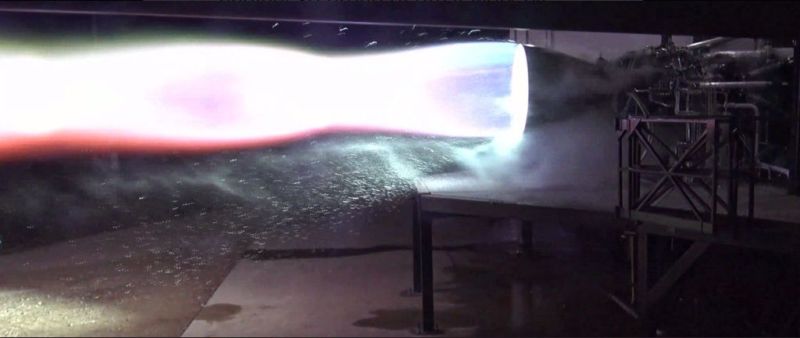
Elon Musk/Twitter
Last Friday, as most Americans slept off their tryptophan hangovers, headed to the mall for Black Friday shopping, or tried in vain to avoid political discussions with visiting family members, SpaceX founder Elon Musk was instead at work. Not finding things to his liking, Musk dashed off an email to the company’s employees. A full copy of the email, obtained by Ars, appears at the end of this story.
Musk told his employees that SpaceX faces a “Raptor production crisis,” which means the company is having difficulty producing enough of the high-tech rocket engines to support plans to test the Starship and Super Heavy vehicles in 2022.
“I was going to take this weekend off, as my first weekend off in a long time, but instead I will be on the Raptor line all night and through the weekend,” Musk wrote. “Unless you have critical family matters or cannot physically return to Hawthorne, we need all hands on deck to recover from what is, quite frankly, a disaster.”
Failing success with this initiative, Musk added, “we face a genuine risk of bankruptcy.”
Someone reading this email from the outside, without too much knowledge about Musk or SpaceX, or the intense capital demands of rockets, would probably think the richest person in the world had gone insane. Or is a huge jerk. Or both. No doubt it will confirm the opinions of people who believe that Musk is a terrible human being.
But there is another side to this story. Truly, Musk is a highly demanding boss. But he is not crazy, and many of his employees appreciate his leadership. Not all, of course.
Why did he send that email?
So why did he send the email? Because SpaceX does face something of a crisis when it comes to Raptor engine production. This is the powerful methane-liquid-oxygen rocket engine that will power both the Super Heavy rocket SpaceX is developing as well as its Starship upper stage. And the situation is apparently worse than Musk understood heading into the Thanksgiving weekend.
This matters because SpaceX has undertaken two immense, unprecedented technological space projects simultaneously. Each will cost billions of dollars—conservatively, $5 billion each, and likely significantly more—to bring to fruition and provide some return on investment. And ultimately, the success of SpaceX hinges on both projects, as they are each to some extent dependent upon the other.
SpaceX is developing the Starship launch system with the ultimate purpose of sending enough people, supplies, power, technology, and more to build a self-sustaining settlement on Mars. That may sound like a wild plan for a private company, but that is Musk’s plan nonetheless. It will require, in Musk’s own estimate, “not less than 1 million tons.” For perspective, the space agencies of NASA, Russia, Europe, and China have together landed considerably less than 10 tons on Mars in the last 60 years. To help fund this settlement initiative, Musk is ultimately counting on revenues from Starlink.
To develop Starship, SpaceX has undertaken a capital-intense project to construct a new spaceport and shipyard in South Texas, near Boca Chica Beach, as well as a massive Raptor engine production facility in Central Texas. (I have heard the company is spending about $1 billion a year to develop the Boca Chica site, named Starbase, but SpaceX has not confirmed this.)
At the same time, SpaceX is building a mega-constellation in low Earth orbit to deliver broadband Internet around the planet. The company’s 1,600 or so functional satellites already in space number more than any other company or country in the world presently operates. Starlink has around 140,000 customers around the world, but the service is far from perfect—and far from being profitable.
To reach truly global and reliable service, SpaceX needs to complete its constellation. This is the “Starlink Satellite V2” that Musk refers to in his email. It represents about 12,000 second-generation satellites that are a bit bulkier than the first edition, as they carry more capacity.
To launch these into orbit would require about 300 launches of SpaceX’s workhorse Falcon 9 rocket. Although the Falcon 9 is the cheapest and most efficient rocket in the world, that is still a costly proposition. Assuming an internal cost of $25 million per launch, that would be $7.5 billion. And that many launches would likely take seven to 10 years, an eternity for Musk. Finally, these launch costs are on top of the billions of dollars to build the satellites themselves and ground terminals for customers to receive signals.
The answer to this conundrum, of course, is the much more massive and fully reusable Starship rocket. A single Starship launch can probably take about 400 Starlink satellites into low Earth orbit. A fully operational Starship, therefore, solves many of SpaceX’s problems. A flight-ready Starship rocket can begin to derive commercial and government launch revenue and also get Starlink into orbit much more quickly, and for much less money.
So in the near term, Musk and SpaceX’s biggest focus is on getting Starship to orbit, proving out the capability to land both the booster and upper stage, and then reusing them. The company hopes to begin Starship orbital test flights in early 2022.
Credit: Source link
The post Here’s why Elon Musk asked his SpaceX employees to work Thanksgiving appeared first on News Full Circle.

Post a Comment